Analysing the Socio-Economic Benefits and Impacts of Globalisation
VerifiedAdded on 2020/05/28
|14
|2750
|388
Report
AI Summary
This research report investigates the socio-economic benefits and impacts of globalisation on developing countries. The study explores the project objective, which is to understand the socio-economic impacts of globalisation on developing countries, investigate the outcome of developing countries exposing themselves to globalisation, and evaluate the effect of globalisation on the income distribution between the developed and developing countries. The report includes a comprehensive literature review on globalisation, foreign direct investment, and its impact on various sectors. It presents research questions, a hypothesis, and a detailed research methodology, including data analysis, sampling, and interview design. The report also addresses research limitations and provides a time schedule for the research process. The conclusion highlights the expected positive and negative impacts of globalisation, such as increased employment opportunities and wealth creation, while acknowledging potential drawbacks like cultural erosion and the spread of diseases.
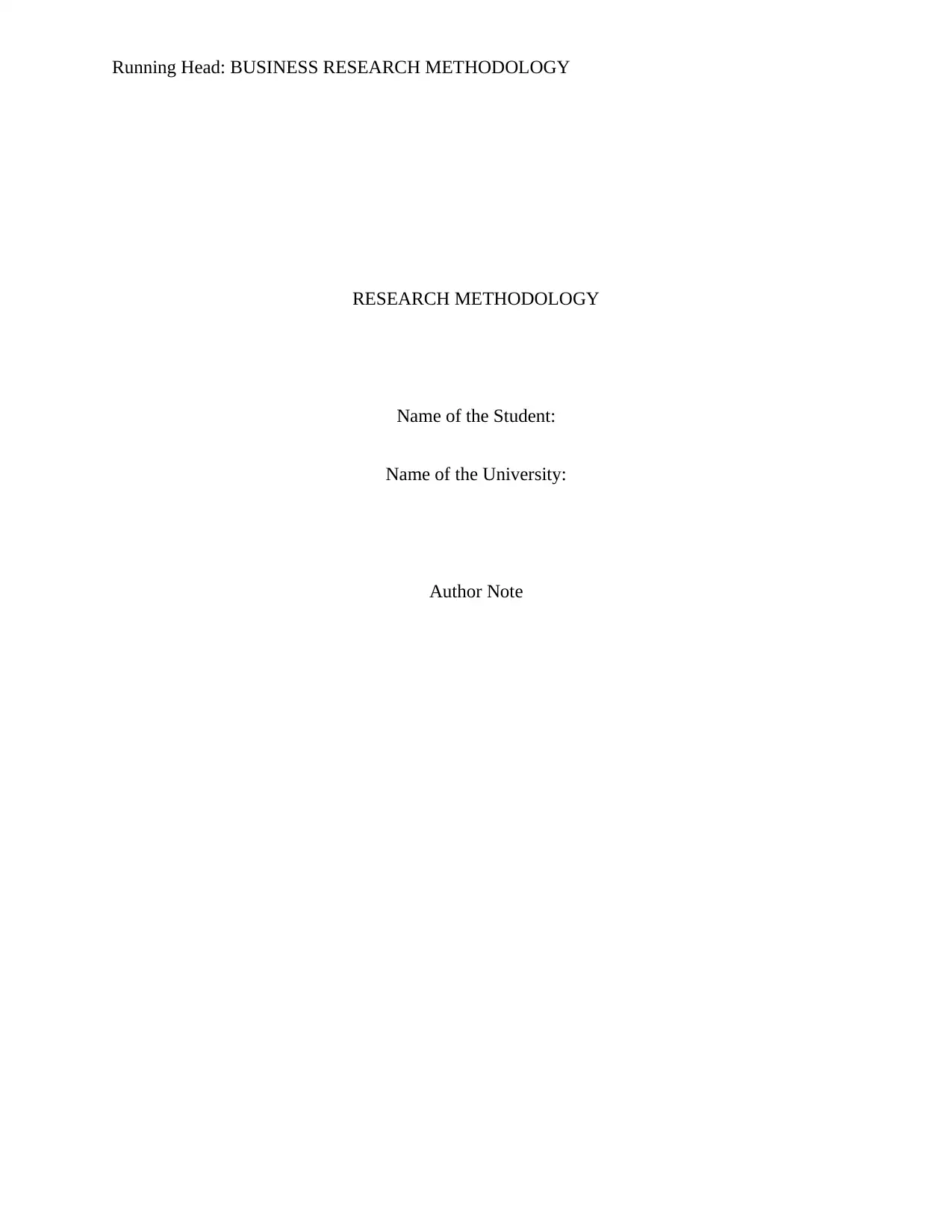
Running Head: BUSINESS RESEARCH METHODOLOGY
RESEARCH METHODOLOGY
Name of the Student:
Name of the University:
Author Note
RESEARCH METHODOLOGY
Name of the Student:
Name of the University:
Author Note
Paraphrase This Document
Need a fresh take? Get an instant paraphrase of this document with our AI Paraphraser
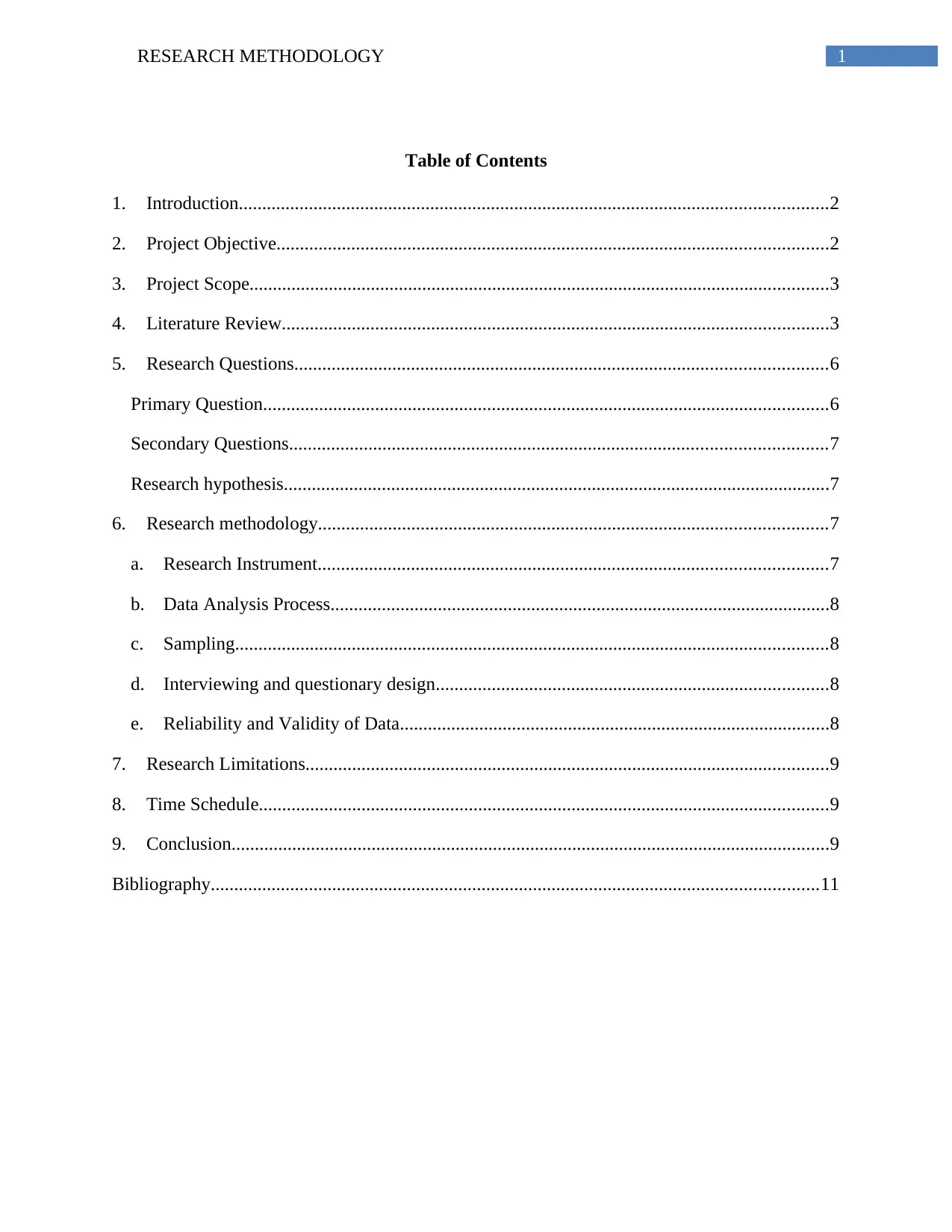
1RESEARCH METHODOLOGY
Table of Contents
1. Introduction..............................................................................................................................2
2. Project Objective......................................................................................................................2
3. Project Scope............................................................................................................................3
4. Literature Review.....................................................................................................................3
5. Research Questions..................................................................................................................6
Primary Question.........................................................................................................................6
Secondary Questions...................................................................................................................7
Research hypothesis.....................................................................................................................7
6. Research methodology.............................................................................................................7
a. Research Instrument.............................................................................................................7
b. Data Analysis Process...........................................................................................................8
c. Sampling...............................................................................................................................8
d. Interviewing and questionary design....................................................................................8
e. Reliability and Validity of Data............................................................................................8
7. Research Limitations................................................................................................................9
8. Time Schedule..........................................................................................................................9
9. Conclusion................................................................................................................................9
Bibliography..................................................................................................................................11
Table of Contents
1. Introduction..............................................................................................................................2
2. Project Objective......................................................................................................................2
3. Project Scope............................................................................................................................3
4. Literature Review.....................................................................................................................3
5. Research Questions..................................................................................................................6
Primary Question.........................................................................................................................6
Secondary Questions...................................................................................................................7
Research hypothesis.....................................................................................................................7
6. Research methodology.............................................................................................................7
a. Research Instrument.............................................................................................................7
b. Data Analysis Process...........................................................................................................8
c. Sampling...............................................................................................................................8
d. Interviewing and questionary design....................................................................................8
e. Reliability and Validity of Data............................................................................................8
7. Research Limitations................................................................................................................9
8. Time Schedule..........................................................................................................................9
9. Conclusion................................................................................................................................9
Bibliography..................................................................................................................................11
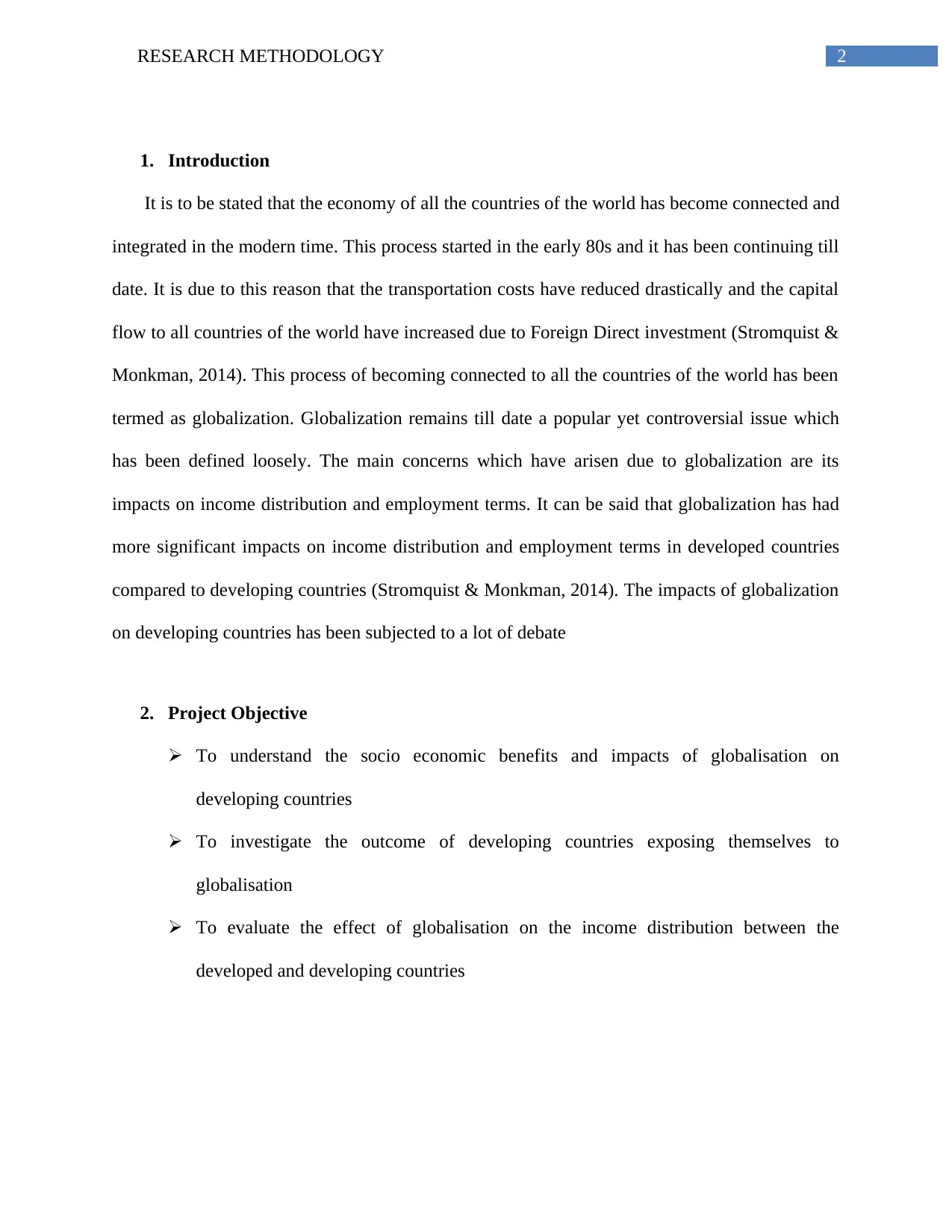
2RESEARCH METHODOLOGY
1. Introduction
It is to be stated that the economy of all the countries of the world has become connected and
integrated in the modern time. This process started in the early 80s and it has been continuing till
date. It is due to this reason that the transportation costs have reduced drastically and the capital
flow to all countries of the world have increased due to Foreign Direct investment (Stromquist &
Monkman, 2014). This process of becoming connected to all the countries of the world has been
termed as globalization. Globalization remains till date a popular yet controversial issue which
has been defined loosely. The main concerns which have arisen due to globalization are its
impacts on income distribution and employment terms. It can be said that globalization has had
more significant impacts on income distribution and employment terms in developed countries
compared to developing countries (Stromquist & Monkman, 2014). The impacts of globalization
on developing countries has been subjected to a lot of debate
2. Project Objective
To understand the socio economic benefits and impacts of globalisation on
developing countries
To investigate the outcome of developing countries exposing themselves to
globalisation
To evaluate the effect of globalisation on the income distribution between the
developed and developing countries
1. Introduction
It is to be stated that the economy of all the countries of the world has become connected and
integrated in the modern time. This process started in the early 80s and it has been continuing till
date. It is due to this reason that the transportation costs have reduced drastically and the capital
flow to all countries of the world have increased due to Foreign Direct investment (Stromquist &
Monkman, 2014). This process of becoming connected to all the countries of the world has been
termed as globalization. Globalization remains till date a popular yet controversial issue which
has been defined loosely. The main concerns which have arisen due to globalization are its
impacts on income distribution and employment terms. It can be said that globalization has had
more significant impacts on income distribution and employment terms in developed countries
compared to developing countries (Stromquist & Monkman, 2014). The impacts of globalization
on developing countries has been subjected to a lot of debate
2. Project Objective
To understand the socio economic benefits and impacts of globalisation on
developing countries
To investigate the outcome of developing countries exposing themselves to
globalisation
To evaluate the effect of globalisation on the income distribution between the
developed and developing countries
⊘ This is a preview!⊘
Do you want full access?
Subscribe today to unlock all pages.

Trusted by 1+ million students worldwide
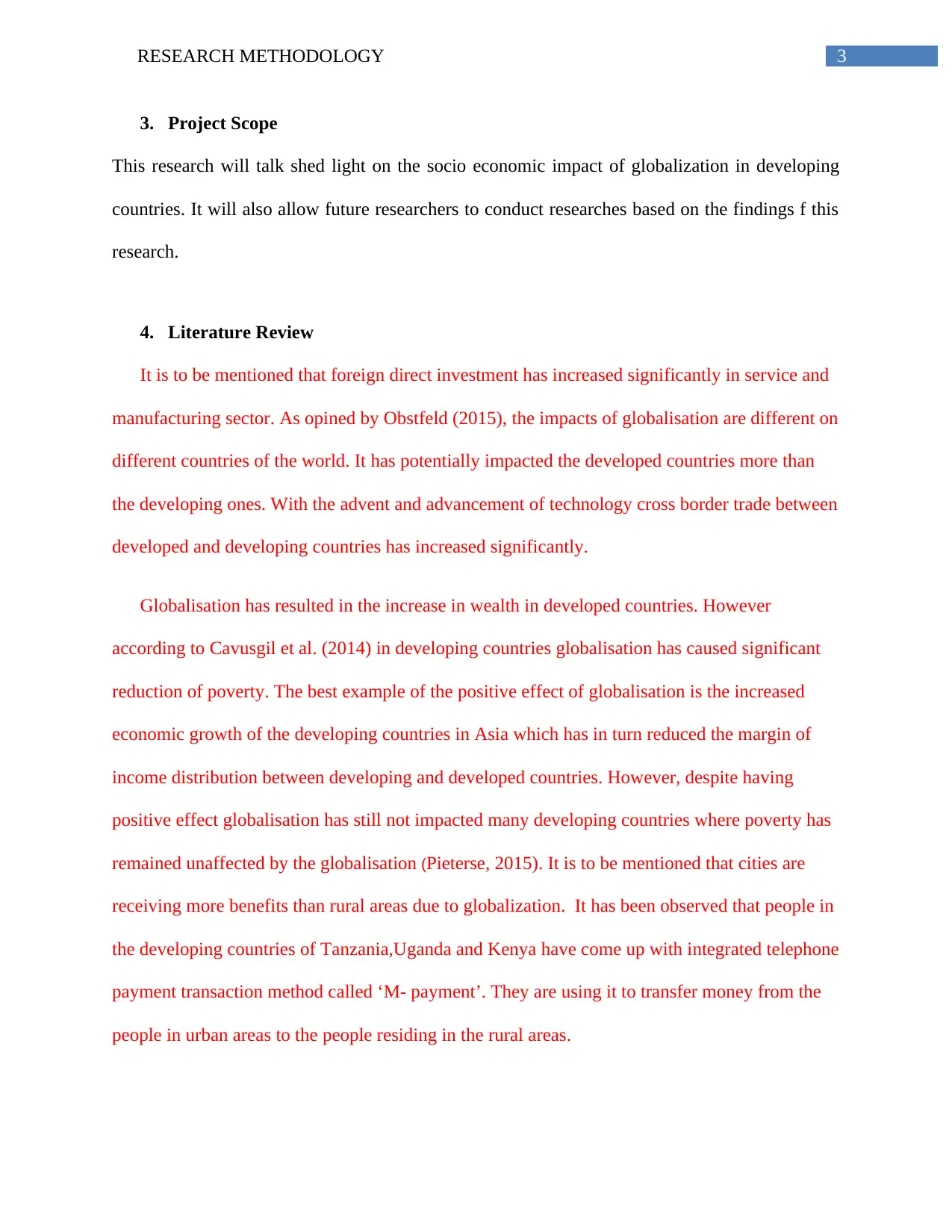
3RESEARCH METHODOLOGY
3. Project Scope
This research will talk shed light on the socio economic impact of globalization in developing
countries. It will also allow future researchers to conduct researches based on the findings f this
research.
4. Literature Review
It is to be mentioned that foreign direct investment has increased significantly in service and
manufacturing sector. As opined by Obstfeld (2015), the impacts of globalisation are different on
different countries of the world. It has potentially impacted the developed countries more than
the developing ones. With the advent and advancement of technology cross border trade between
developed and developing countries has increased significantly.
Globalisation has resulted in the increase in wealth in developed countries. However
according to Cavusgil et al. (2014) in developing countries globalisation has caused significant
reduction of poverty. The best example of the positive effect of globalisation is the increased
economic growth of the developing countries in Asia which has in turn reduced the margin of
income distribution between developing and developed countries. However, despite having
positive effect globalisation has still not impacted many developing countries where poverty has
remained unaffected by the globalisation (Pieterse, 2015). It is to be mentioned that cities are
receiving more benefits than rural areas due to globalization. It has been observed that people in
the developing countries of Tanzania,Uganda and Kenya have come up with integrated telephone
payment transaction method called ‘M- payment’. They are using it to transfer money from the
people in urban areas to the people residing in the rural areas.
3. Project Scope
This research will talk shed light on the socio economic impact of globalization in developing
countries. It will also allow future researchers to conduct researches based on the findings f this
research.
4. Literature Review
It is to be mentioned that foreign direct investment has increased significantly in service and
manufacturing sector. As opined by Obstfeld (2015), the impacts of globalisation are different on
different countries of the world. It has potentially impacted the developed countries more than
the developing ones. With the advent and advancement of technology cross border trade between
developed and developing countries has increased significantly.
Globalisation has resulted in the increase in wealth in developed countries. However
according to Cavusgil et al. (2014) in developing countries globalisation has caused significant
reduction of poverty. The best example of the positive effect of globalisation is the increased
economic growth of the developing countries in Asia which has in turn reduced the margin of
income distribution between developing and developed countries. However, despite having
positive effect globalisation has still not impacted many developing countries where poverty has
remained unaffected by the globalisation (Pieterse, 2015). It is to be mentioned that cities are
receiving more benefits than rural areas due to globalization. It has been observed that people in
the developing countries of Tanzania,Uganda and Kenya have come up with integrated telephone
payment transaction method called ‘M- payment’. They are using it to transfer money from the
people in urban areas to the people residing in the rural areas.
Paraphrase This Document
Need a fresh take? Get an instant paraphrase of this document with our AI Paraphraser
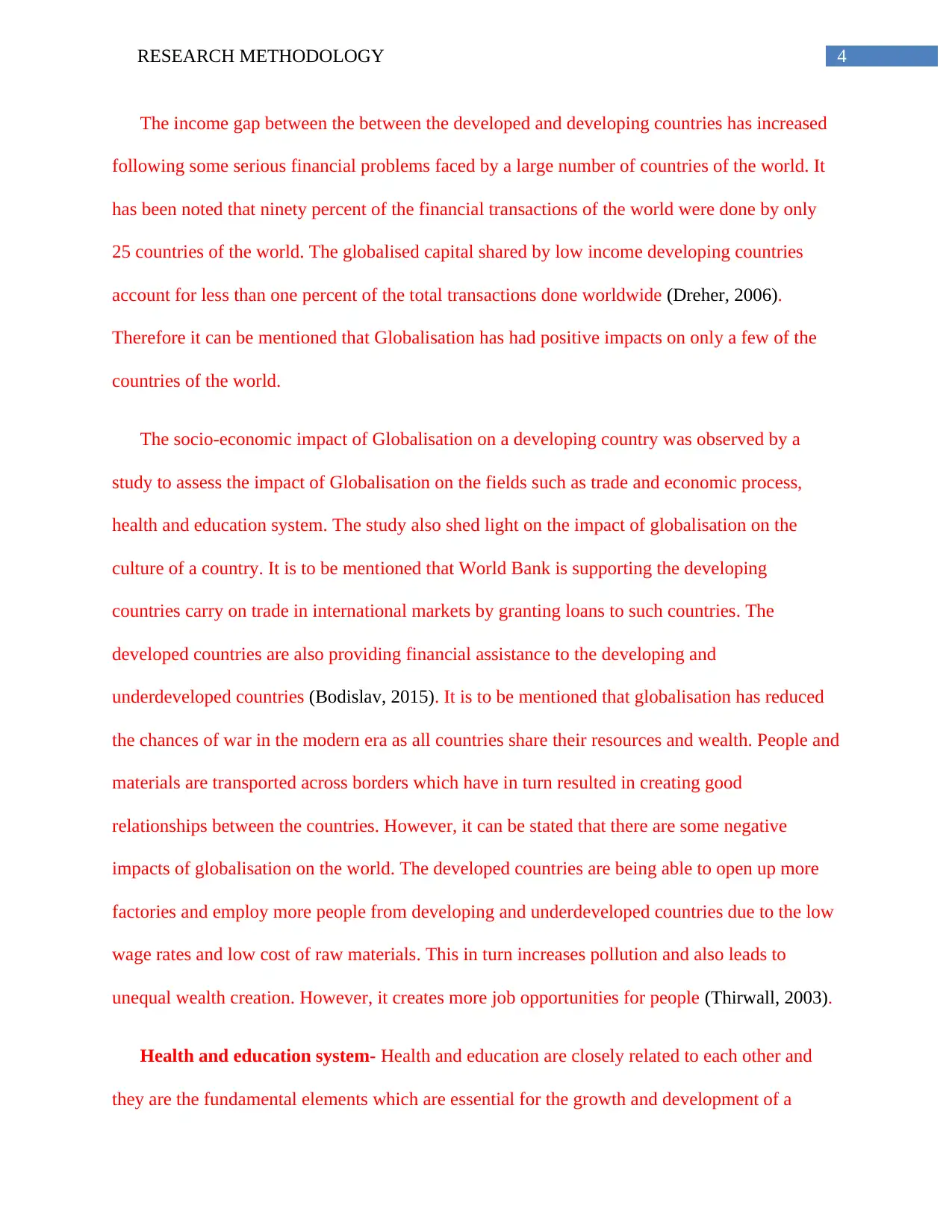
4RESEARCH METHODOLOGY
The income gap between the between the developed and developing countries has increased
following some serious financial problems faced by a large number of countries of the world. It
has been noted that ninety percent of the financial transactions of the world were done by only
25 countries of the world. The globalised capital shared by low income developing countries
account for less than one percent of the total transactions done worldwide (Dreher, 2006).
Therefore it can be mentioned that Globalisation has had positive impacts on only a few of the
countries of the world.
The socio-economic impact of Globalisation on a developing country was observed by a
study to assess the impact of Globalisation on the fields such as trade and economic process,
health and education system. The study also shed light on the impact of globalisation on the
culture of a country. It is to be mentioned that World Bank is supporting the developing
countries carry on trade in international markets by granting loans to such countries. The
developed countries are also providing financial assistance to the developing and
underdeveloped countries (Bodislav, 2015). It is to be mentioned that globalisation has reduced
the chances of war in the modern era as all countries share their resources and wealth. People and
materials are transported across borders which have in turn resulted in creating good
relationships between the countries. However, it can be stated that there are some negative
impacts of globalisation on the world. The developed countries are being able to open up more
factories and employ more people from developing and underdeveloped countries due to the low
wage rates and low cost of raw materials. This in turn increases pollution and also leads to
unequal wealth creation. However, it creates more job opportunities for people (Thirwall, 2003).
Health and education system- Health and education are closely related to each other and
they are the fundamental elements which are essential for the growth and development of a
The income gap between the between the developed and developing countries has increased
following some serious financial problems faced by a large number of countries of the world. It
has been noted that ninety percent of the financial transactions of the world were done by only
25 countries of the world. The globalised capital shared by low income developing countries
account for less than one percent of the total transactions done worldwide (Dreher, 2006).
Therefore it can be mentioned that Globalisation has had positive impacts on only a few of the
countries of the world.
The socio-economic impact of Globalisation on a developing country was observed by a
study to assess the impact of Globalisation on the fields such as trade and economic process,
health and education system. The study also shed light on the impact of globalisation on the
culture of a country. It is to be mentioned that World Bank is supporting the developing
countries carry on trade in international markets by granting loans to such countries. The
developed countries are also providing financial assistance to the developing and
underdeveloped countries (Bodislav, 2015). It is to be mentioned that globalisation has reduced
the chances of war in the modern era as all countries share their resources and wealth. People and
materials are transported across borders which have in turn resulted in creating good
relationships between the countries. However, it can be stated that there are some negative
impacts of globalisation on the world. The developed countries are being able to open up more
factories and employ more people from developing and underdeveloped countries due to the low
wage rates and low cost of raw materials. This in turn increases pollution and also leads to
unequal wealth creation. However, it creates more job opportunities for people (Thirwall, 2003).
Health and education system- Health and education are closely related to each other and
they are the fundamental elements which are essential for the growth and development of a
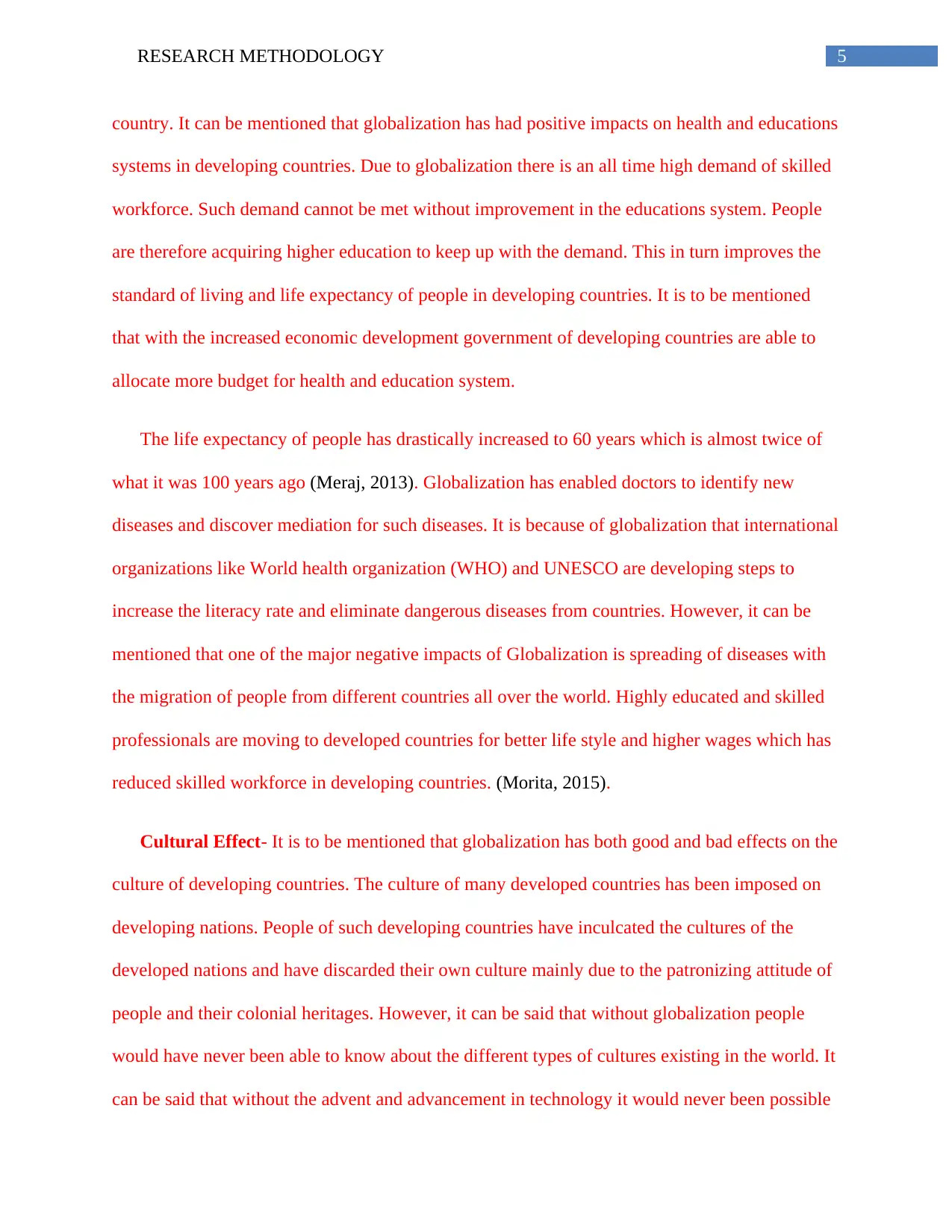
5RESEARCH METHODOLOGY
country. It can be mentioned that globalization has had positive impacts on health and educations
systems in developing countries. Due to globalization there is an all time high demand of skilled
workforce. Such demand cannot be met without improvement in the educations system. People
are therefore acquiring higher education to keep up with the demand. This in turn improves the
standard of living and life expectancy of people in developing countries. It is to be mentioned
that with the increased economic development government of developing countries are able to
allocate more budget for health and education system.
The life expectancy of people has drastically increased to 60 years which is almost twice of
what it was 100 years ago (Meraj, 2013). Globalization has enabled doctors to identify new
diseases and discover mediation for such diseases. It is because of globalization that international
organizations like World health organization (WHO) and UNESCO are developing steps to
increase the literacy rate and eliminate dangerous diseases from countries. However, it can be
mentioned that one of the major negative impacts of Globalization is spreading of diseases with
the migration of people from different countries all over the world. Highly educated and skilled
professionals are moving to developed countries for better life style and higher wages which has
reduced skilled workforce in developing countries. (Morita, 2015).
Cultural Effect- It is to be mentioned that globalization has both good and bad effects on the
culture of developing countries. The culture of many developed countries has been imposed on
developing nations. People of such developing countries have inculcated the cultures of the
developed nations and have discarded their own culture mainly due to the patronizing attitude of
people and their colonial heritages. However, it can be said that without globalization people
would have never been able to know about the different types of cultures existing in the world. It
can be said that without the advent and advancement in technology it would never been possible
country. It can be mentioned that globalization has had positive impacts on health and educations
systems in developing countries. Due to globalization there is an all time high demand of skilled
workforce. Such demand cannot be met without improvement in the educations system. People
are therefore acquiring higher education to keep up with the demand. This in turn improves the
standard of living and life expectancy of people in developing countries. It is to be mentioned
that with the increased economic development government of developing countries are able to
allocate more budget for health and education system.
The life expectancy of people has drastically increased to 60 years which is almost twice of
what it was 100 years ago (Meraj, 2013). Globalization has enabled doctors to identify new
diseases and discover mediation for such diseases. It is because of globalization that international
organizations like World health organization (WHO) and UNESCO are developing steps to
increase the literacy rate and eliminate dangerous diseases from countries. However, it can be
mentioned that one of the major negative impacts of Globalization is spreading of diseases with
the migration of people from different countries all over the world. Highly educated and skilled
professionals are moving to developed countries for better life style and higher wages which has
reduced skilled workforce in developing countries. (Morita, 2015).
Cultural Effect- It is to be mentioned that globalization has both good and bad effects on the
culture of developing countries. The culture of many developed countries has been imposed on
developing nations. People of such developing countries have inculcated the cultures of the
developed nations and have discarded their own culture mainly due to the patronizing attitude of
people and their colonial heritages. However, it can be said that without globalization people
would have never been able to know about the different types of cultures existing in the world. It
can be said that without the advent and advancement in technology it would never been possible
⊘ This is a preview!⊘
Do you want full access?
Subscribe today to unlock all pages.

Trusted by 1+ million students worldwide
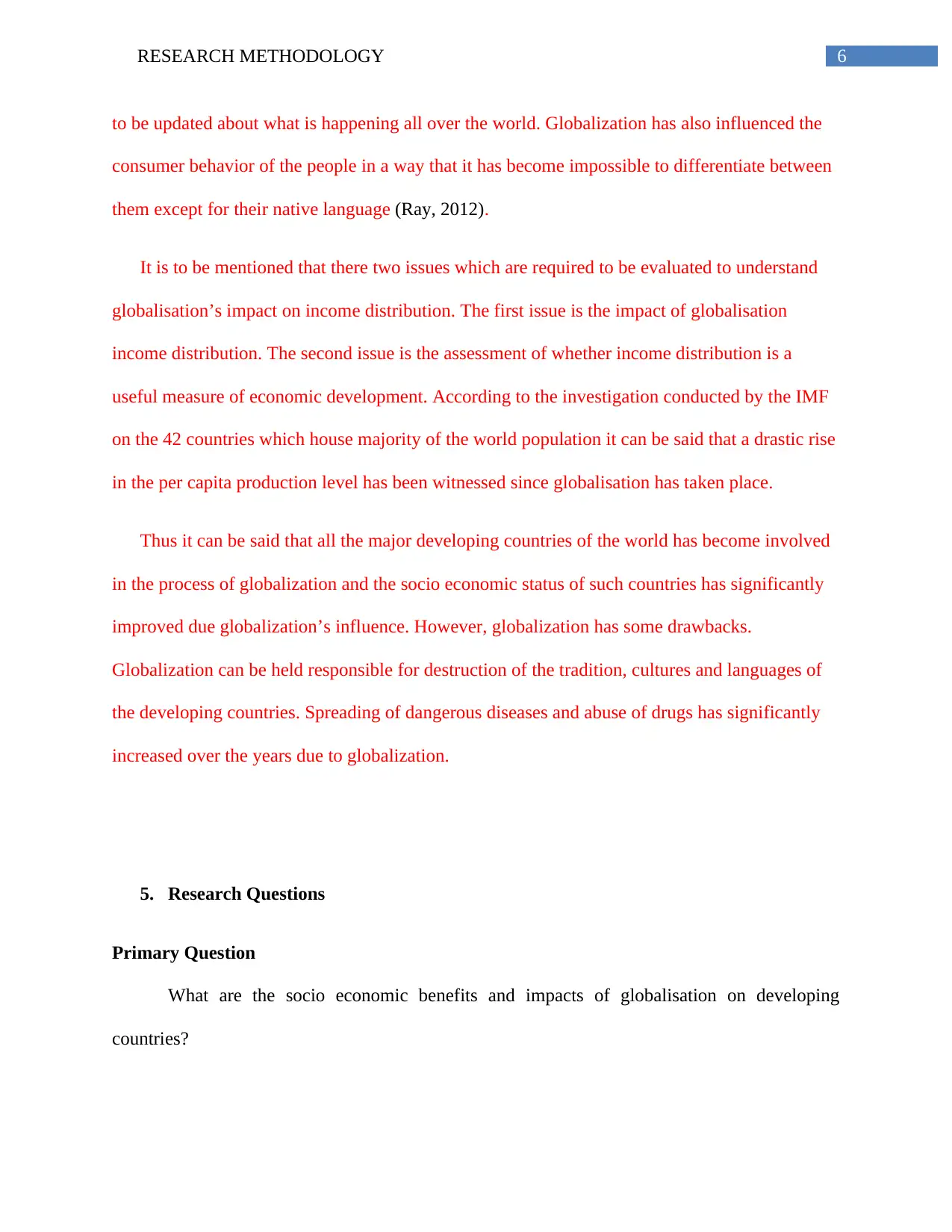
6RESEARCH METHODOLOGY
to be updated about what is happening all over the world. Globalization has also influenced the
consumer behavior of the people in a way that it has become impossible to differentiate between
them except for their native language (Ray, 2012).
It is to be mentioned that there two issues which are required to be evaluated to understand
globalisation’s impact on income distribution. The first issue is the impact of globalisation
income distribution. The second issue is the assessment of whether income distribution is a
useful measure of economic development. According to the investigation conducted by the IMF
on the 42 countries which house majority of the world population it can be said that a drastic rise
in the per capita production level has been witnessed since globalisation has taken place.
Thus it can be said that all the major developing countries of the world has become involved
in the process of globalization and the socio economic status of such countries has significantly
improved due globalization’s influence. However, globalization has some drawbacks.
Globalization can be held responsible for destruction of the tradition, cultures and languages of
the developing countries. Spreading of dangerous diseases and abuse of drugs has significantly
increased over the years due to globalization.
5. Research Questions
Primary Question
What are the socio economic benefits and impacts of globalisation on developing
countries?
to be updated about what is happening all over the world. Globalization has also influenced the
consumer behavior of the people in a way that it has become impossible to differentiate between
them except for their native language (Ray, 2012).
It is to be mentioned that there two issues which are required to be evaluated to understand
globalisation’s impact on income distribution. The first issue is the impact of globalisation
income distribution. The second issue is the assessment of whether income distribution is a
useful measure of economic development. According to the investigation conducted by the IMF
on the 42 countries which house majority of the world population it can be said that a drastic rise
in the per capita production level has been witnessed since globalisation has taken place.
Thus it can be said that all the major developing countries of the world has become involved
in the process of globalization and the socio economic status of such countries has significantly
improved due globalization’s influence. However, globalization has some drawbacks.
Globalization can be held responsible for destruction of the tradition, cultures and languages of
the developing countries. Spreading of dangerous diseases and abuse of drugs has significantly
increased over the years due to globalization.
5. Research Questions
Primary Question
What are the socio economic benefits and impacts of globalisation on developing
countries?
Paraphrase This Document
Need a fresh take? Get an instant paraphrase of this document with our AI Paraphraser
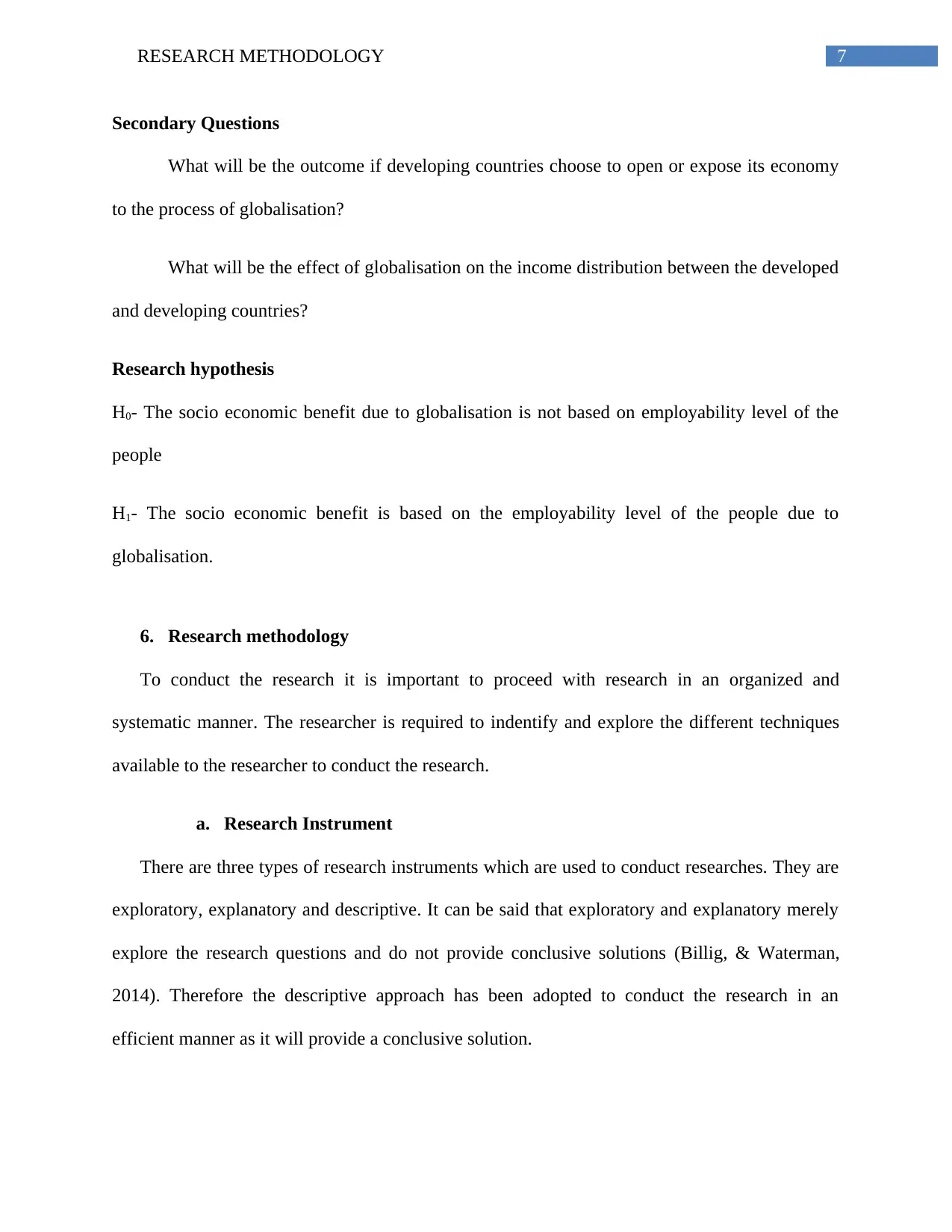
7RESEARCH METHODOLOGY
Secondary Questions
What will be the outcome if developing countries choose to open or expose its economy
to the process of globalisation?
What will be the effect of globalisation on the income distribution between the developed
and developing countries?
Research hypothesis
H0- The socio economic benefit due to globalisation is not based on employability level of the
people
H1- The socio economic benefit is based on the employability level of the people due to
globalisation.
6. Research methodology
To conduct the research it is important to proceed with research in an organized and
systematic manner. The researcher is required to indentify and explore the different techniques
available to the researcher to conduct the research.
a. Research Instrument
There are three types of research instruments which are used to conduct researches. They are
exploratory, explanatory and descriptive. It can be said that exploratory and explanatory merely
explore the research questions and do not provide conclusive solutions (Billig, & Waterman,
2014). Therefore the descriptive approach has been adopted to conduct the research in an
efficient manner as it will provide a conclusive solution.
Secondary Questions
What will be the outcome if developing countries choose to open or expose its economy
to the process of globalisation?
What will be the effect of globalisation on the income distribution between the developed
and developing countries?
Research hypothesis
H0- The socio economic benefit due to globalisation is not based on employability level of the
people
H1- The socio economic benefit is based on the employability level of the people due to
globalisation.
6. Research methodology
To conduct the research it is important to proceed with research in an organized and
systematic manner. The researcher is required to indentify and explore the different techniques
available to the researcher to conduct the research.
a. Research Instrument
There are three types of research instruments which are used to conduct researches. They are
exploratory, explanatory and descriptive. It can be said that exploratory and explanatory merely
explore the research questions and do not provide conclusive solutions (Billig, & Waterman,
2014). Therefore the descriptive approach has been adopted to conduct the research in an
efficient manner as it will provide a conclusive solution.
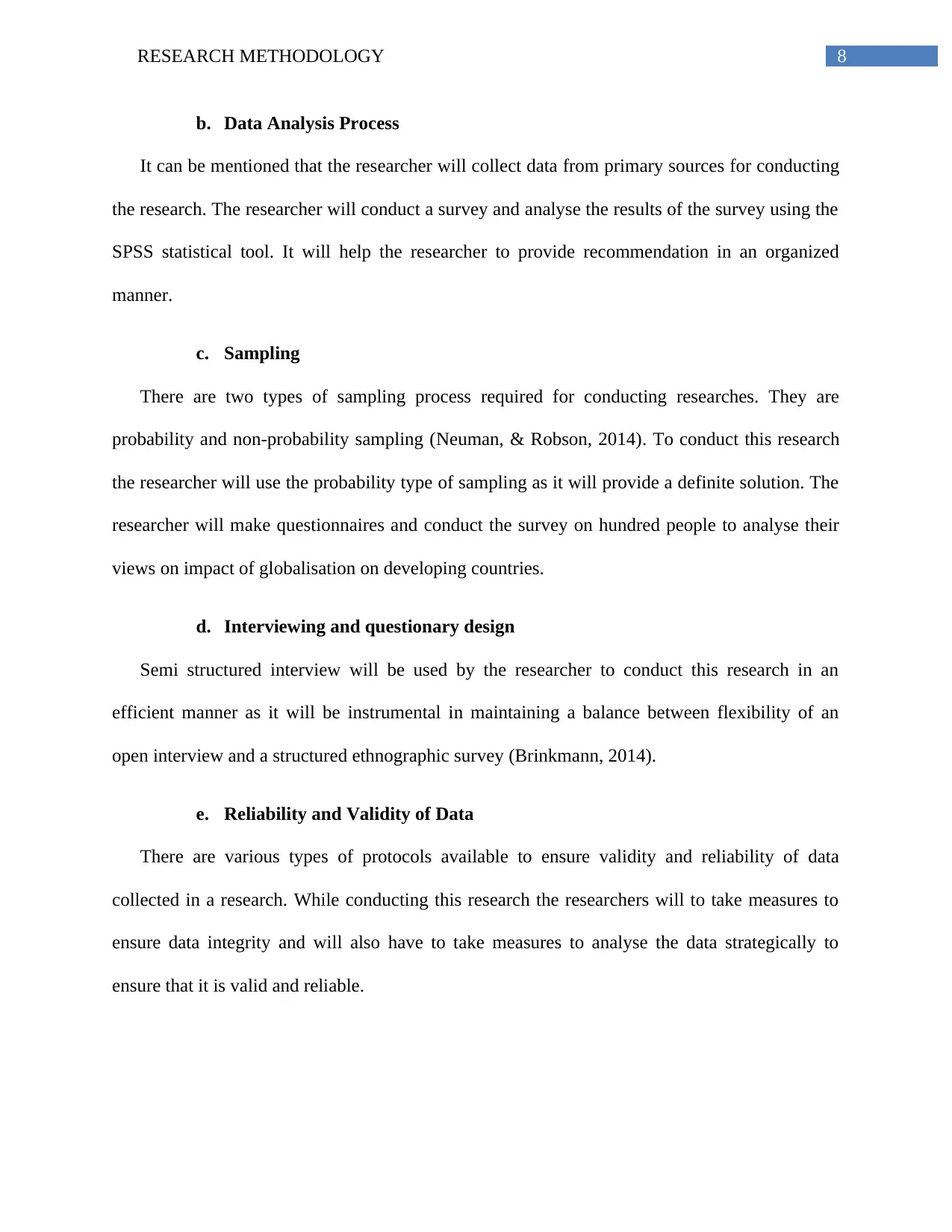
8RESEARCH METHODOLOGY
b. Data Analysis Process
It can be mentioned that the researcher will collect data from primary sources for conducting
the research. The researcher will conduct a survey and analyse the results of the survey using the
SPSS statistical tool. It will help the researcher to provide recommendation in an organized
manner.
c. Sampling
There are two types of sampling process required for conducting researches. They are
probability and non-probability sampling (Neuman, & Robson, 2014). To conduct this research
the researcher will use the probability type of sampling as it will provide a definite solution. The
researcher will make questionnaires and conduct the survey on hundred people to analyse their
views on impact of globalisation on developing countries.
d. Interviewing and questionary design
Semi structured interview will be used by the researcher to conduct this research in an
efficient manner as it will be instrumental in maintaining a balance between flexibility of an
open interview and a structured ethnographic survey (Brinkmann, 2014).
e. Reliability and Validity of Data
There are various types of protocols available to ensure validity and reliability of data
collected in a research. While conducting this research the researchers will to take measures to
ensure data integrity and will also have to take measures to analyse the data strategically to
ensure that it is valid and reliable.
b. Data Analysis Process
It can be mentioned that the researcher will collect data from primary sources for conducting
the research. The researcher will conduct a survey and analyse the results of the survey using the
SPSS statistical tool. It will help the researcher to provide recommendation in an organized
manner.
c. Sampling
There are two types of sampling process required for conducting researches. They are
probability and non-probability sampling (Neuman, & Robson, 2014). To conduct this research
the researcher will use the probability type of sampling as it will provide a definite solution. The
researcher will make questionnaires and conduct the survey on hundred people to analyse their
views on impact of globalisation on developing countries.
d. Interviewing and questionary design
Semi structured interview will be used by the researcher to conduct this research in an
efficient manner as it will be instrumental in maintaining a balance between flexibility of an
open interview and a structured ethnographic survey (Brinkmann, 2014).
e. Reliability and Validity of Data
There are various types of protocols available to ensure validity and reliability of data
collected in a research. While conducting this research the researchers will to take measures to
ensure data integrity and will also have to take measures to analyse the data strategically to
ensure that it is valid and reliable.
⊘ This is a preview!⊘
Do you want full access?
Subscribe today to unlock all pages.

Trusted by 1+ million students worldwide
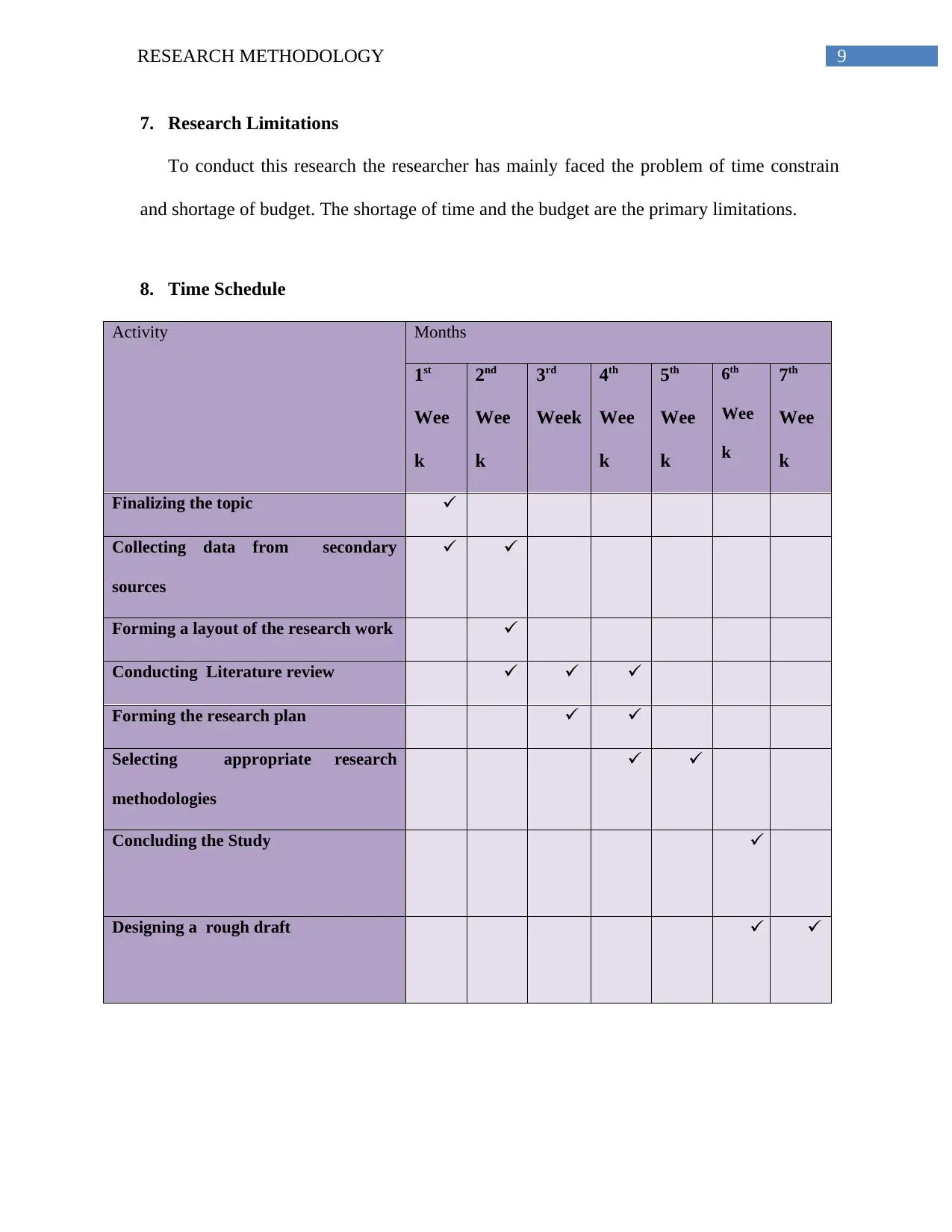
9RESEARCH METHODOLOGY
7. Research Limitations
To conduct this research the researcher has mainly faced the problem of time constrain
and shortage of budget. The shortage of time and the budget are the primary limitations.
8. Time Schedule
Activity Months
1st
Wee
k
2nd
Wee
k
3rd
Week
4th
Wee
k
5th
Wee
k
6th
Wee
k
7th
Wee
k
Finalizing the topic
Collecting data from secondary
sources
Forming a layout of the research work
Conducting Literature review
Forming the research plan
Selecting appropriate research
methodologies
Concluding the Study
Designing a rough draft
7. Research Limitations
To conduct this research the researcher has mainly faced the problem of time constrain
and shortage of budget. The shortage of time and the budget are the primary limitations.
8. Time Schedule
Activity Months
1st
Wee
k
2nd
Wee
k
3rd
Week
4th
Wee
k
5th
Wee
k
6th
Wee
k
7th
Wee
k
Finalizing the topic
Collecting data from secondary
sources
Forming a layout of the research work
Conducting Literature review
Forming the research plan
Selecting appropriate research
methodologies
Concluding the Study
Designing a rough draft
Paraphrase This Document
Need a fresh take? Get an instant paraphrase of this document with our AI Paraphraser
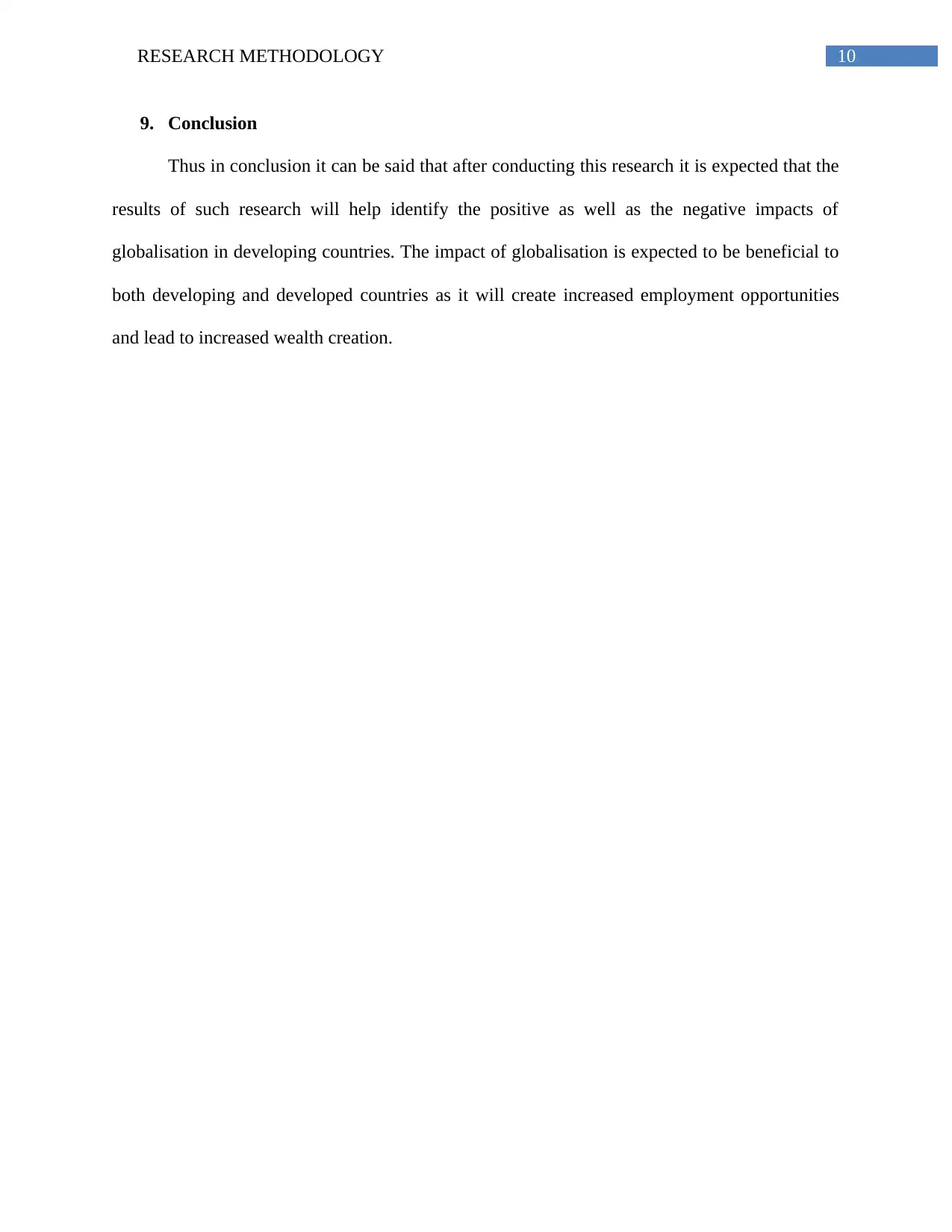
10RESEARCH METHODOLOGY
9. Conclusion
Thus in conclusion it can be said that after conducting this research it is expected that the
results of such research will help identify the positive as well as the negative impacts of
globalisation in developing countries. The impact of globalisation is expected to be beneficial to
both developing and developed countries as it will create increased employment opportunities
and lead to increased wealth creation.
9. Conclusion
Thus in conclusion it can be said that after conducting this research it is expected that the
results of such research will help identify the positive as well as the negative impacts of
globalisation in developing countries. The impact of globalisation is expected to be beneficial to
both developing and developed countries as it will create increased employment opportunities
and lead to increased wealth creation.
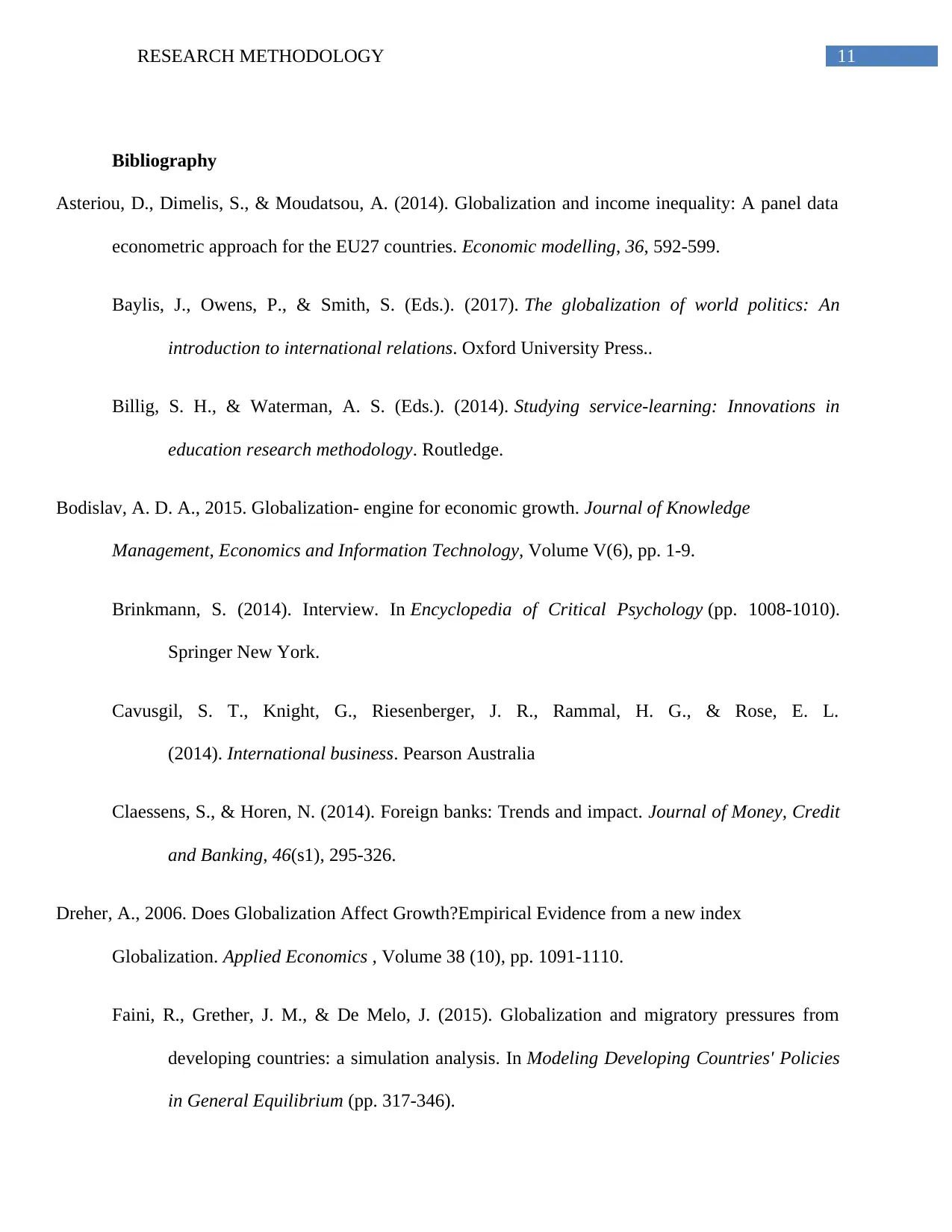
11RESEARCH METHODOLOGY
Bibliography
Asteriou, D., Dimelis, S., & Moudatsou, A. (2014). Globalization and income inequality: A panel data
econometric approach for the EU27 countries. Economic modelling, 36, 592-599.
Baylis, J., Owens, P., & Smith, S. (Eds.). (2017). The globalization of world politics: An
introduction to international relations. Oxford University Press..
Billig, S. H., & Waterman, A. S. (Eds.). (2014). Studying service-learning: Innovations in
education research methodology. Routledge.
Bodislav, A. D. A., 2015. Globalization- engine for economic growth. Journal of Knowledge
Management, Economics and Information Technology, Volume V(6), pp. 1-9.
Brinkmann, S. (2014). Interview. In Encyclopedia of Critical Psychology (pp. 1008-1010).
Springer New York.
Cavusgil, S. T., Knight, G., Riesenberger, J. R., Rammal, H. G., & Rose, E. L.
(2014). International business. Pearson Australia
Claessens, S., & Horen, N. (2014). Foreign banks: Trends and impact. Journal of Money, Credit
and Banking, 46(s1), 295-326.
Dreher, A., 2006. Does Globalization Affect Growth?Empirical Evidence from a new index
Globalization. Applied Economics , Volume 38 (10), pp. 1091-1110.
Faini, R., Grether, J. M., & De Melo, J. (2015). Globalization and migratory pressures from
developing countries: a simulation analysis. In Modeling Developing Countries' Policies
in General Equilibrium (pp. 317-346).
Bibliography
Asteriou, D., Dimelis, S., & Moudatsou, A. (2014). Globalization and income inequality: A panel data
econometric approach for the EU27 countries. Economic modelling, 36, 592-599.
Baylis, J., Owens, P., & Smith, S. (Eds.). (2017). The globalization of world politics: An
introduction to international relations. Oxford University Press..
Billig, S. H., & Waterman, A. S. (Eds.). (2014). Studying service-learning: Innovations in
education research methodology. Routledge.
Bodislav, A. D. A., 2015. Globalization- engine for economic growth. Journal of Knowledge
Management, Economics and Information Technology, Volume V(6), pp. 1-9.
Brinkmann, S. (2014). Interview. In Encyclopedia of Critical Psychology (pp. 1008-1010).
Springer New York.
Cavusgil, S. T., Knight, G., Riesenberger, J. R., Rammal, H. G., & Rose, E. L.
(2014). International business. Pearson Australia
Claessens, S., & Horen, N. (2014). Foreign banks: Trends and impact. Journal of Money, Credit
and Banking, 46(s1), 295-326.
Dreher, A., 2006. Does Globalization Affect Growth?Empirical Evidence from a new index
Globalization. Applied Economics , Volume 38 (10), pp. 1091-1110.
Faini, R., Grether, J. M., & De Melo, J. (2015). Globalization and migratory pressures from
developing countries: a simulation analysis. In Modeling Developing Countries' Policies
in General Equilibrium (pp. 317-346).
⊘ This is a preview!⊘
Do you want full access?
Subscribe today to unlock all pages.

Trusted by 1+ million students worldwide
1 out of 14
Related Documents
Your All-in-One AI-Powered Toolkit for Academic Success.
+13062052269
info@desklib.com
Available 24*7 on WhatsApp / Email
![[object Object]](/_next/static/media/star-bottom.7253800d.svg)
Unlock your academic potential
Copyright © 2020–2025 A2Z Services. All Rights Reserved. Developed and managed by ZUCOL.





